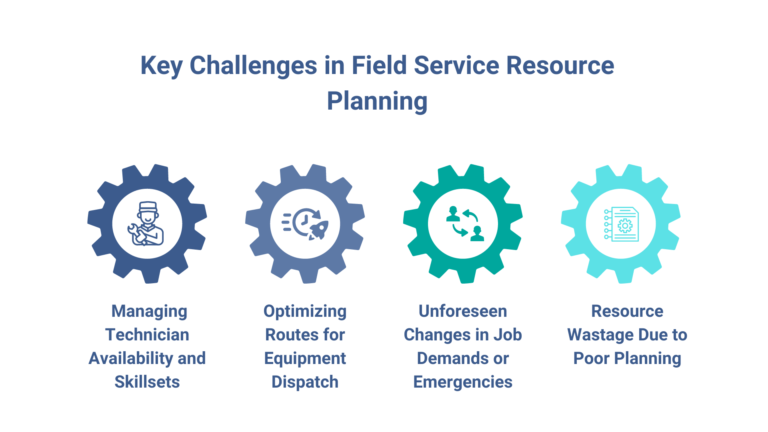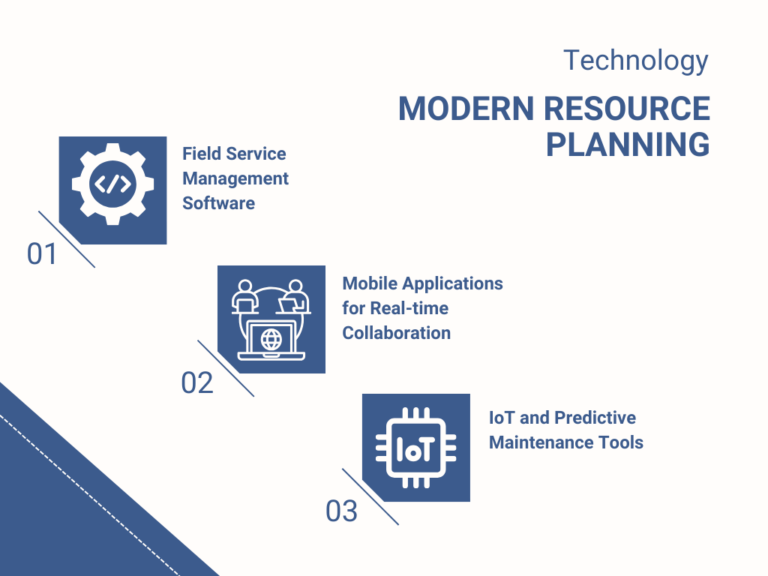In today’s competitive landscape, field service operations live or die by how well they manage their resources. Inefficiencies in resource planning lead to wasted time, ballooning costs, and, worst of all, unhappy customers.
To stay ahead, companies must embrace effective resource planning strategies that not only optimize their operations but also drive business success.
Let’s explore resource planning in field service operations and the tools and strategies that can transform your approach from reactive to proactive.
Resource planning is the process of efficiently managing and allocating resources, namely personnel and equipment, to ensure the effective and timely delivery of services.
It involves:
In field service operations, resource planning plays a critical role in:
Resource planning guarantees that the right people and equipment are in the right place at the right time. It also helps companies manage their overall operational costs, reduce response times, and improve service delivery quality.
While resource planning is highly important, field service companies often face several challenges, such as-
Field service often involves a variety of tasks requiring specialized skills which can create an imbalanced workforce. Certain technicians may be high demand while others may have limited relevant expertise.
Additionally, vacations, sick days, and unforeseen absences can cause gaps in scheduling. This can make it difficult to ensure a constant flow of skilled labor.
Another challenge is route optimization for dispatching equipment and technicians. Poorly planned routes can lead to delays, wasted fuel, and missed service windows.
In some cases, managers may dispatch technicians from distant locations when a closer technician is available. In addition, field employees may overlook necessary equipment due to poor planning, resulting in multiple trips and wasted time.
Field service operations are highly dynamic. Sudden changes in job demands, such as urgent repairs or emergencies, can throw off pre-established schedules.
These shifts require immediate adjustments in resource allocation. As a result, it may become challenging to ensure that managers efficiently reassign technicians without disrupting other planned tasks.
Poor resource planning can result in significant waste, both in terms of labor and equipment. Idle technicians, who are either waiting for their next assignment or sent to jobs they’re not suited for, can lead to lost productivity.
Similarly, dispatching the wrong tools or insufficient equipment can cause delays, leading to extended job completion times or additional trips to the service site. This not only wastes resources but also negatively impacts customer satisfaction.

Effective resource planning in field service operations provides numerous advantages, not just for the business but also for the end customer. Here are some key benefits:
By effectively planning resource you can make the best use of technicians’ time and skills. Field service managers can ensure that they send the right technician to the right job based on their expertise and proximity.
This eliminates underutilization or overburdening certain workers. So, you can expect a more balanced workload and improved productivity across the workforce.

Effective resource planning significantly cuts operational costs by optimizing the dispatch of resources. This includes everything from ensuring that technicians follow the most efficient routes to delivering the necessary tools and parts at the right time.
By reducing wasted trips, idle time, and misallocated resources, Organizations can decrease fuel costs, vehicle wear-and-tear, and technician overtime. Proper planning ensures fewer mistakes, reducing the need for rework and cutting unnecessary expenses.
Better resource planning leads to faster response times and fewer delays in service. By sending the right technician with the right equipment, job completion is quicker. There are also fewer disruptions for the customer.
This results in improved service levels and higher customer satisfaction. Both are critical in retaining clients and maintaining a positive brand reputation. Reduced wait times, first-time fixes, and proactive maintenance also contribute to a seamless customer experience.
Optimizing resources in field service operations requires leveraging technology and data-driven decision-making. Here are some of the best practices to ensure efficient resource allocation:
Workforce planning is the foundation of resource optimization. Assign tasks based on technician proximity to the job site, their skill sets, certifications, and overall availability. This ensures the most qualified technician performs the job in the shortest amount of time.
By tracking technician skills and experience, managers can match the complexity of the job to the right technician. This can improve first-time fix rates and overall efficiency.
Unexpected changes such as emergencies or sudden job cancellations are common. Dynamic scheduling involves using intelligent systems that can reallocate resources in real-time based on these evolving conditions.
For instance, if a high-priority emergency arises, dynamic scheduling tools can automatically adjust the schedule. Thus, they can send the nearest available technician with the right skill set, minimizing downtime and service delays. This flexibility helps avoid bottlenecks and ensures continuous operation.
Proper inventory and equipment management is another critical aspect of resource optimization. By tracking inventory levels in real-time, companies can ensure that technicians have the right tools and parts before they head to the job site.
This reduces the risk of job delays due to missing or incorrect equipment and ensures that all necessary materials are available when needed. Additionally, monitoring equipment usage and availability allows companies to proactively manage maintenance and replacement schedules, preventing last-minute disruptions.
Technology plays a crucial role in enhancing resource planning efficiency. Leveraging modern tools and software not only streamlines the entire process but also improves collaboration and enables real-time decision-making.
Here are some key technologies that facilitate effective resource planning:

Field service management software is at the core of modern resource planning. These platforms enable companies to coordinate and manage their field service operations from a centralized hub.
Field service management software can schedule jobs, assign tasks based on technician availability and skills, and monitor job progress in real time. With integrated features such as route optimization, asset management, and automated dispatching, it enhances both the efficiency and accuracy of resource allocation. This allowing companies to promptly meet customer demands.
Mobile applications are critical for real-time collaboration between field technicians and back-office staff. They enable technicians to receive job details, update job statuses, and report issues instantly while in the field.
The back office can provide support, track progress, and reassign tasks if necessary, using live updates from the field. This real-time communication ensures that any unforeseen issues, such as equipment malfunctions or delays, get swift resolution. So, it can help you prevent bottlenecks and improve overall service delivery.
By installing IoT sensors in equipment and machinery, companies can monitor the condition of their assets in real time. Predictive maintenance tools analyze asset service history data and forecast potential equipment failures. Companies can proactively allocate resources for maintenance before a breakdown occurs.
This minimizes downtime, ensures optimal technician scheduling, and prevents costly emergency repairs.
While you can rely on various service providers to cover these needs, it’s highly beneficial to opt for a comprehensive solution. This will not only ensure seamless operations but will also scale as your business grows.
First, evaluate your current resource planning processes. Identify bottlenecks in your operations, such as inefficiencies in scheduling, delays in equipment dispatch, or issues with technician utilization.
Understanding these pain points will give you a clearer picture of where improvements are necessary.
Selecting the right technology is key to successful implementation. Invest in software that integrates multiple functionalities, such as mobile collaboration, real-time tracking, and intelligent dispatching.
FieldEquip, for example, is a leading field service software provider that offers a complete field service management solution. FieldEquip’s platform helps streamline workforce management, track industrial assets, and optimize scheduling in real time, all of which contribute to more effective resource planning.
Track key performance metrics such as technician utilization, response times, and job completion rates to identify areas for improvement. An ongoing feedback loop will help ensure that your resource planning system evolves with the changing needs of the business.
Effective resource planning is the backbone of successful field service operations. It can help you enhance efficiency, reduce operational costs, and deliver a superior customer experience.
By leveraging advanced technologies like FieldEquip, you can transform your field service operations, ensuring that they stay agile, cost-effective, and responsive to customer needs. If you’re ready to enhance your resource planning, schedule a demo with FieldEquip today to see how it can revolutionize your field service operations.
Would you like to have a free demo or have any questions about FieldEquip?
US Corporate Headquarters 1011 S. Hwy. 6, Suite 117 Houston Texas 77077 US